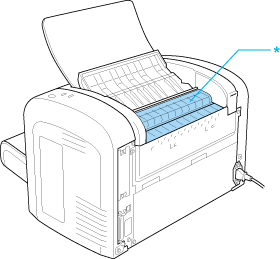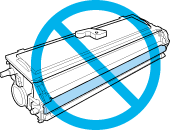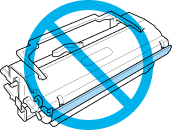|
Warnings, Cautions, and Notes
 |
Warnings
|
 | |
must be followed carefully to avoid bodily injury.
|
|
 |
Cautions
|
 | |
must be observed to avoid damage to your equipment.
|
|
 |
Notes
|
 | |
contain important information and useful tips on the operation of your printer.
|
|
Safety Precautions
Be sure to follow these precautions carefully to ensure safe, efficient operation:
-
Be careful not to touch the fuser, which is marked CAUTION Hot Surface, or the surrounding areas. If the printer has been in use, the fuser and the surrounding areas may be very hot.

* CAUTION Hot Surface
-
Avoid touching the components inside the printer unless instructed to do so in this guide.
-
Never force the printer's components into place. Although the printer is designed to be sturdy, rough handling can damage it.
-
When removing the developer cartridge, never touch the developing roller under the flap; otherwise, print quality will decline.

-
When handling the developer cartridge, always place it on a clean, smooth surface.
-
Do not turn the developer cartridge upside down or stand it on its ends.
-
Do not attempt to modify or take the developer cartridge apart. It cannot be refilled.
-
Do not touch the toner and avoid all contact with your eyes.
-
If toner is spilled, use a broom and dustpan or a damp cloth with soap and water to clean it up. Because the fine particles can cause a fire or explosion if they come into contact with a spark, do not use a vacuum cleaner.
-
When removing or installing a photoconductor unit, protect the light-sensitive drum from exposure to light any longer than necessary. The light-sensitive drum is the green cylinder visible through the openings in the unit. Overexposing the drum might cause abnormally dark or light areas to appear on the printed page and may shorten the service life of the unit.

-
Be careful not to scratch the surface of the drum. When you remove the photoconductor unit from the printer, always place the unit on a clean, smooth surface. Avoid touching the drum, since oils from your skin can permanently damage its surface and affect print quality.
-
To get the best print quality, do not store the photoconductor unit in an area subject to direct sunlight, dust, salt air, or corrosive gases (such as ammonia). Avoid locations subject to extreme or rapid changes in temperature or humidity.
-
Wait for at least one hour before using a developer cartridge or a photoconductor unit after moving it from a cool to a warm environment to prevent damage from condensation.
-
Do not dispose of developer cartridges or photoconductor units in fire, as they can explode and cause injury. Dispose of them according to local regulations.
-
Be sure to keep consumable components out of the reach of children.
-
Do not leave jammed paper inside the printer. This can cause the printer to overheat.
-
Avoid using electrical outlets that other appliances are plugged into.
-
Use only an outlet that meets the power requirements of this printer.
Important Safety Instructions
-
Follow all warnings and instructions marked on the printer.
-
Unplug the printer from the wall outlet before cleaning.
-
Use a well-wrung cloth for cleaning and do not use liquid or aerosol cleaners.
-
Do not use this printer in a damp environment.
-
Place the printer near an electrical outlet where you can easily plug in and unplug the power cord.
-
Do not place the printer on an unstable surface.
-
Do not put your printer where the cord will be stepped on.
-
Slots and openings in the cabinet and the back or bottom are provided for ventilation. Do not block or cover them. Do not put the printer on a bed, sofa, rug, or other similar surface, or in a built-in installation unless proper ventilation is provided.
-
Connect your printer to an electrical outlet that meets the power requirements of this printer. Your printer's power requirements are indicated on a label attached to the printer. If you are not sure of the power supply specifications in your area, contact your local power company or consult your dealer.
-
If you are unable to insert the AC plug into the electrical outlet, contact an electrician.
-
Avoid using outlets that other appliances are plugged into.
-
Use the type of power source indicated on the label. If you are not sure of the type of power available, consult your dealer or local power company.
-
If you are unable to insert the plug into the outlet, contact a qualified electrician.
-
Adjust only those controls that are covered by the operating instructions, as improper adjustment of other controls may result in damage and may require repairs by a qualified service representative.
-
If you use an extension cord, make sure that the total of the ampere ratings on the products plugged into the extension cord does not exceed the extension cord ampere rating.
-
Never push objects of any kind through cabinet slots as they may touch dangerous voltage points or short out parts that could result in a fire or electric shock.
-
Never spill liquid of any kind on the printer.
-
Except as specifically explained in this guide, do not attempt to service this product yourself. Opening or removing covers that are marked
Do Not Remove may expose you to dangerous voltage points or other risks. Refer all servicing in those compartments to service personnel.
-
Unplug this printer from the wall outlet and refer servicing to qualified service personnel under the following conditions:
A. When the power cord or plug is damaged or frayed.
B. If liquid has been spilled into it.
C. If it has been exposed to rain or water.
D. If it does not operate normally when the operating instructions are followed. Adjust only those controls that are covered by the operating instructions since improper adjustment of other controls may result in damage and will often require extensive work by a qualified technician to restore the product to normal operation.
E. If it has been dropped or the cabinet has been damaged.
F. If it exhibits a distinct change in performance, indicating a need for service.
Safety Information
Power cord
 |
Caution:
|
 | |
Be sure the AC power cord meets the relevant local safety standards.
|
|
Use only the power cord that comes with this product. Use of other cords may result in fire or electric shock. This product's power cord is for use with this product only. Use with other equipment may result in fire or electric shock.
Laser safety labels
 |
Warning:
|
 | |
The performance of procedures and adjustments other than those specified in this guide may result in hazardous radiation exposure.
|
|
Your printer is a Class 1 laser product as defined in the IEC60825 specifications.
The label shown on the right is attached to the back of the printer in countries where required.

Internal laser radiation
Max. Average Radiation Power:
36.903 \xb5 W at laser aperture of the print head unit
Wavelength:
770 to 800 nm
This is a Class III b Laser Diode Assembly that has an invisible laser beam. The printer head unit is NOT A SERVICE ITEM, Therefore, the printer head unit should not be opened under any circumstances.
CDRH regulations
For information about the Center for Devices and Radiological Health of the U.S. Food and Drug Administration, see the Reference Guide on the CD-ROM.
Ozone safety
Ozone emission
Ozone gas is generated by laser printers as a by-product of the printing process. Ozone is produced only when the printer is printing.
Ozone exposure limit
The recommended exposure limit for ozone is 0.1 parts per million (ppm), expressed as an average time-weighted concentration over an 8-hour period.
The EPSON EPL-6200/EPL-6200L laser printer generates less than 0.1 ppm for 8 hours of continuous printing.
Minimize the risk
To minimize the risk of exposure to ozone, you should avoid the following conditions:
-
Use of multiple laser printers in a confined area
-
Operation in conditions of extremely low humidity
-
Long, continuous printing together with any of the above
Printer location
The printer should be located so that the exhaust gases and heat generated are:
-
Not blown directly into the user's face
-
Vented directly out of the building whenever possible
Power On/Off Cautions
 |
Caution:
|
 | |
Do not turn off the printer:
|
|
 | -
Until the Ready light (green) comes on and is not flashing.
|
|
 | -
While the Data (Ready light for EPL-6200L) light (yellow) is flashing.
|
|
|
Warnings, Cautions, and Notes
Safety Precautions
Important Safety Instructions
Safety Information
Power On/Off Cautions